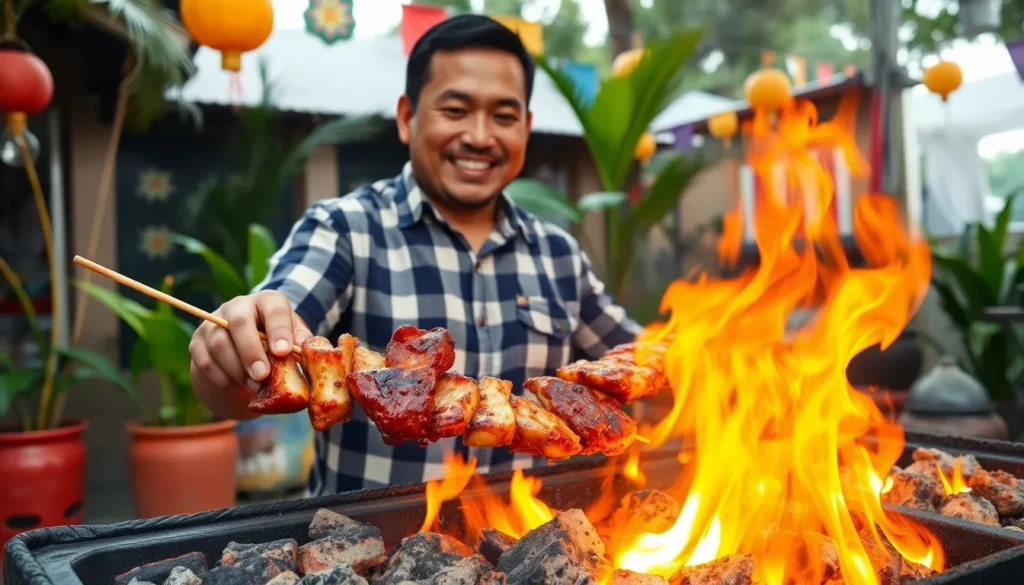Filipino Pork BBQ brings the vibrant flavors of the Philippines straight to your backyard grill. This beloved street food staple combines tender pork skewers with a perfect balance of sweet and savory marinades that’ll make your taste buds dance. We’ve perfected this authentic recipe that captures the essence of Manila’s bustling barbecue stalls.
What sets Filipino pork BBQ apart from other grilled meats is its distinctive marinade featuring soy sauce, brown sugar, and aromatic spices. The secret lies in the overnight marination process that infuses every fiber of the pork with incredible flavor. When grilled over charcoal, these skewers develop a beautiful caramelized crust while staying juicy inside.
We’ll show you how to create this crowd-pleasing dish that’s perfect for family gatherings, weekend cookouts, or whenever you’re craving something extraordinary. Get ready to impress your guests with authentic Filipino flavors that’ll have everyone asking for seconds.
Ingredients
We’ve carefully selected each ingredient to deliver the authentic Filipino BBQ experience that makes this dish irresistible. Our recipe uses traditional components that create the perfect balance of sweet, savory, and smoky flavors.
For the Pork
- 2 pounds pork shoulder, cut into 1-inch thick strips
- 1 pound pork belly, sliced into strips (optional for extra richness)
- Bamboo skewers, soaked in water for 30 minutes
For the Marinade
- 1/2 cup soy sauce (preferably Filipino brand like Silver Swan)
- 1/4 cup brown sugar, packed
- 1/4 cup banana ketchup or tomato ketchup
- 3 tablespoons calamansi juice or fresh lemon juice
- 6 cloves garlic, minced
- 1 medium onion, finely chopped
- 2 tablespoons oyster sauce
- 1 tablespoon fish sauce
- 1 teaspoon ground black pepper
- 1 teaspoon paprika
- 1/2 teaspoon ground ginger
- 2 bay leaves
For the Sauce
- 1/4 cup reserved marinade
- 2 tablespoons brown sugar
- 1 tablespoon banana ketchup
- 1 teaspoon soy sauce
- 1 tablespoon butter
- 1 tablespoon water
Equipment Needed

Preparing authentic Filipino pork BBQ requires exact equipment to achieve that perfect smoky flavor and tender texture we’re aiming for. Our equipment list focuses on essential tools that will help you create restaurant-quality results at home.
Essential Grilling Equipment
Outdoor Grill serves as the foundation of our cooking process. Charcoal grills deliver the best smoky flavor, though gas grills work well for convenience. We recommend having a grill with adjustable heat zones to control cooking temperature effectively.
Bamboo Skewers measuring 12 inches provide the traditional presentation for Filipino pork BBQ. Stainless steel skewers offer a reusable alternative that conducts heat evenly through the meat. Both options work excellently, though bamboo skewers require soaking in water for at least 30 minutes before use.
Instant-Read Thermometer ensures our pork reaches the safe internal temperature of 145°F while maintaining juiciness. This tool eliminates guesswork and prevents overcooking, which can dry out the meat.
Preparation Tools
Large Mixing Bowl accommodates all marinade ingredients and pork pieces for thorough coating. Choose a bowl with enough capacity to allow proper mixing without spillage.
Basting Brush helps apply our glaze during the final grilling stages. Silicone brushes withstand high heat better than natural bristles and clean easily after use.
Tongs provide safe handling of skewers on the hot grill surface. Long-handled tongs keep hands away from heat while allowing precise control over turning and positioning.
Optional Equipment
| Equipment | Purpose | Benefit |
|---|---|---|
| Grill Basket | Prevents small pieces from falling | Easier handling |
| Meat Mallet | Tenderizes tougher cuts | Improved texture |
| Aluminum Foil | Creates heat shields | Even cooking |
Digital Timer helps track marinating time and cooking duration for consistent results. Proper timing ensures our marinade penetrates fully and our pork cooks evenly throughout.
Having the right equipment makes the difference between good Filipino pork BBQ and exceptional results that rival your favorite Filipino restaurant.
Prep Instructions
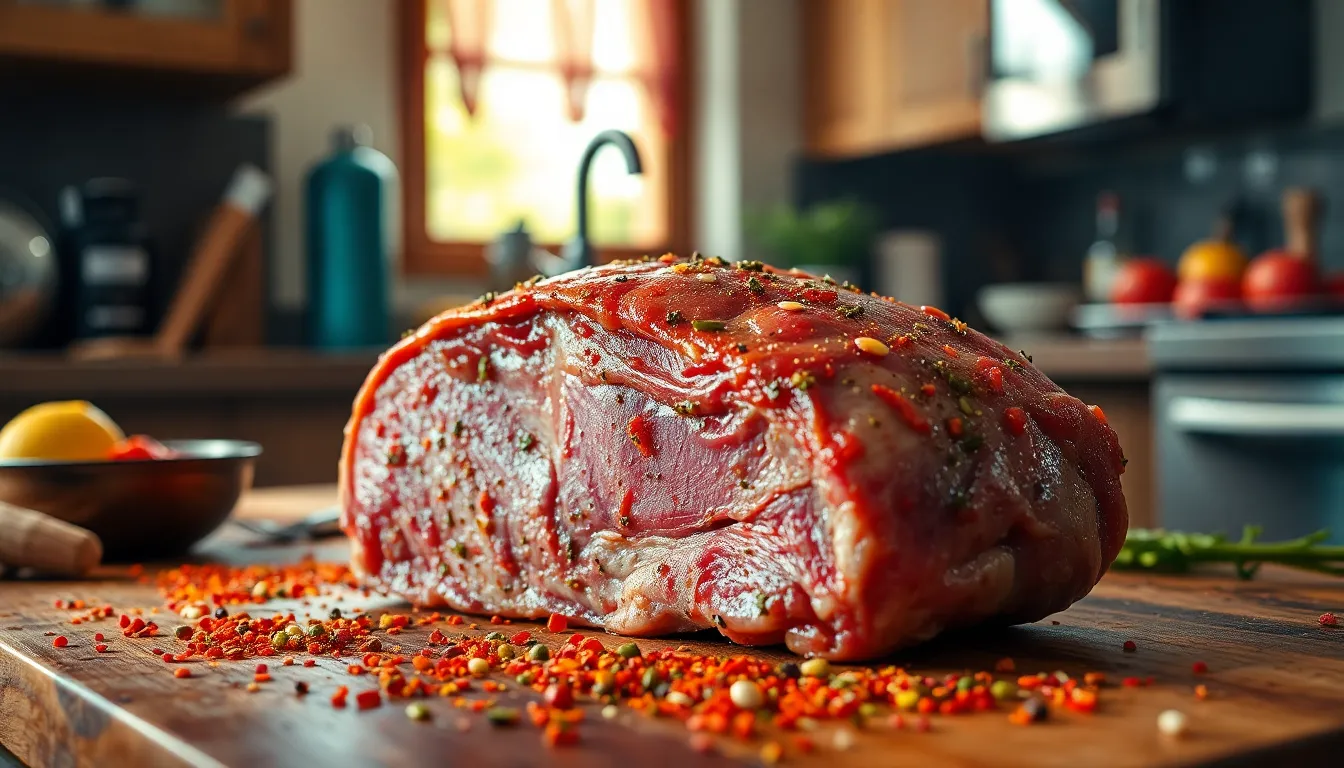
Proper preparation forms the foundation of exceptional Filipino pork BBQ. We’ll guide you through each essential step to ensure your barbecue achieves the perfect balance of flavors and textures.
Preparing the Pork
We start by selecting 3 to 5 pounds of pork shoulder or butt for our Filipino BBQ. Cut the meat into 1 to 2-inch pieces to ensure even cooking and optimal marinade absorption. These uniform pieces allow the flavors to penetrate thoroughly while maintaining the tender texture that makes this dish so beloved.
Wooden skewers require advance preparation to prevent burning during grilling. Soak them in water for at least 30 minutes before threading the pork. This simple step protects the skewers from charring and ensures they remain sturdy throughout the cooking process.
Making the Marinade
Our marinade combines traditional Filipino ingredients to create the signature sweet and savory profile. We begin with 1 to 1.5 cups of soy sauce as our base, providing the essential umami foundation. Add 1 to 1.5 cups of brown sugar to balance the saltiness with rich sweetness.
Fresh calamansi juice brings bright acidity to our mixture. Use 1/4 to 1/2 cup of calamansi juice, or substitute with lemon or lime juice if calamansi is unavailable. The citrus helps tenderize the meat while adding authentic Filipino flavor.
Optional ingredients enhance the marinade’s complexity. Banana ketchup adds 1 cup of fruity sweetness and vibrant color that distinguishes Filipino BBQ. Ginger ale or 7-Up contributes 1 cup of effervescence and additional sweetness. For heat, include 4 to 8 pieces of wild chili or 2 cloves of minced garlic. Season with 1 to 2 teaspoons of ground black pepper for subtle spice.
Whisk all marinade ingredients together in a large bowl until the brown sugar completely dissolves. The mixture should appear smooth and well combined, ready to transform our pork into authentic Filipino barbecue.
Marinating the Pork
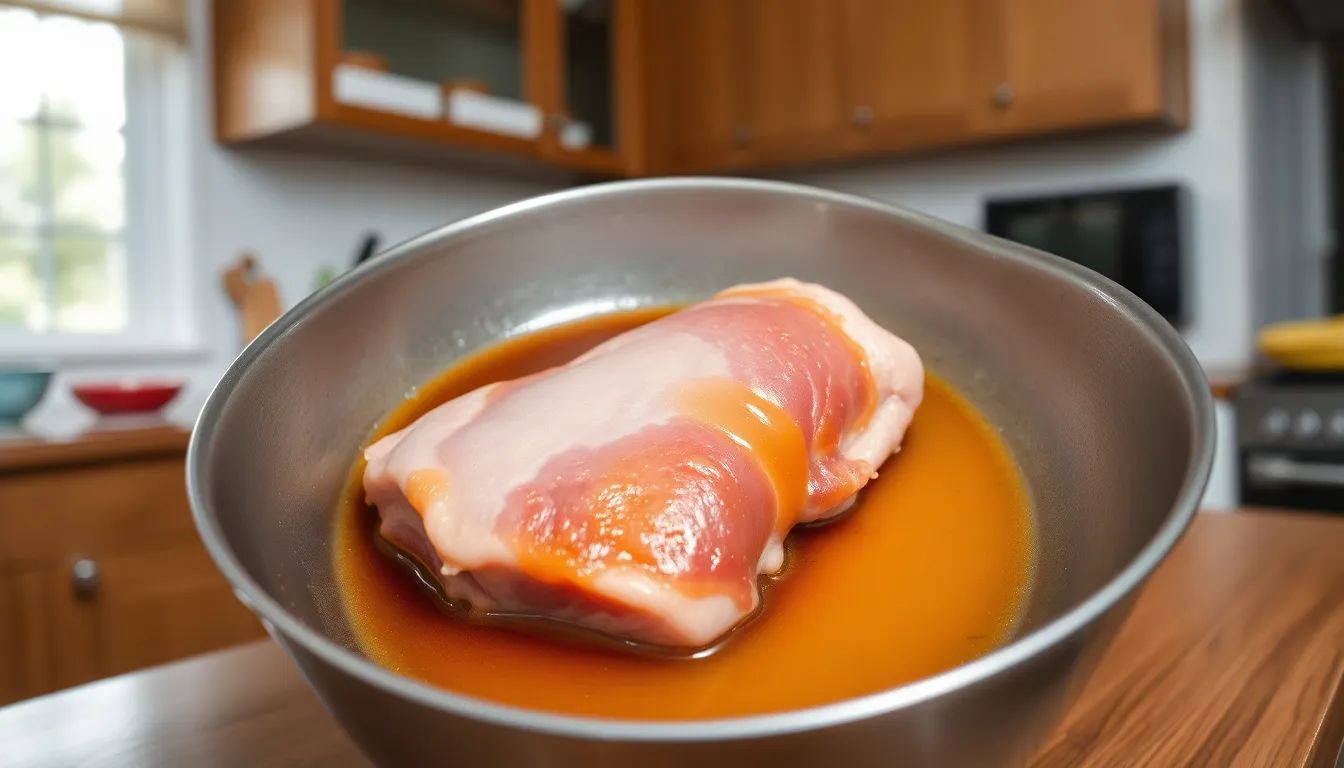
The marinating process transforms ordinary pork into the signature Filipino barbecue we all love. Place the pork pieces in a large mixing bowl or container that can accommodate all the meat comfortably. Pour the prepared marinade over the pork pieces ensuring every piece gets thoroughly coated.
Toss the pork gently with your hands or large spoons to distribute the marinade evenly. Each piece should be completely covered with the sweet and savory mixture. The marinade needs time to penetrate the meat fibers and infuse those authentic Filipino flavors throughout.
Cover the container tightly with plastic wrap or transfer everything to a sealed storage bag. Refrigerate the marinated pork for a minimum of 3 to 4 hours. But we strongly recommend marinating overnight for the best results. The extended marination time allows the soy sauce and calamansi juice to tenderize the meat while the brown sugar and banana ketchup create that signature sweet glaze.
| Marinating Time | Flavor Result |
|---|---|
| 3-4 hours | Good flavor penetration |
| 6-8 hours | Better flavor development |
| Overnight (12+ hours) | Optimal tenderness and flavor |
During the marinating process the acids from the calamansi juice break down tough muscle fibers making the pork incredibly tender. The soda adds effervescence that helps the marinade penetrate deeper into the meat. Turn the pork pieces occasionally if marinating for extended periods to ensure even flavor distribution.
Remove the pork from the refrigerator 30 minutes before grilling to bring it to room temperature. Reserve about 1 cup of the marinade for basting during the cooking process. The remaining marinade should be discarded as it has been in contact with raw pork.
Thread the marinated pork pieces onto the pre-soaked skewers leaving small spaces between each piece for even cooking. The meat should be tender and fragrant with a beautiful reddish-brown color from the marinade absorption.
Cooking Instructions

Now that our pork has absorbed all those amazing Filipino flavors we’re ready to transform it into irresistible barbecue. We’ll explore three proven cooking methods that each deliver authentic results.
Grilling Method
We begin by preheating our grill to medium-high heat for optimal cooking temperature. The charcoal method delivers the most authentic flavor but gas grills work perfectly too.
Place the marinated pork skewers directly on the grill grates. Cook each side for 3 to 5 minutes creating those beautiful caramelized edges that make Filipino BBQ so appealing. We flip the skewers only once to maintain the meat’s juiciness.
Basting becomes crucial during grilling to achieve that signature glossy finish. We brush our reserved marinade or basting sauce onto the pork every few minutes. This technique prevents drying while building layers of sweet and savory flavors.
Monitor the internal temperature until it reaches 145°F for food safety. The exterior should develop a rich mahogany color with slightly charred edges. Allow the meat to rest for 5 to 10 minutes before serving to redistribute the juices.
Oven Method
Preheat the oven to 375°F and line a baking sheet with aluminum foil for easy cleanup. We position a wire rack over the foil to elevate the skewers and promote even air circulation.
Arrange our pork skewers on the rack with space between each piece. Bake for 20 to 25 minutes turning the skewers halfway through cooking. This rotation ensures uniform browning on all sides.
We baste the pork with our reserved marinade or sauce every 10 minutes during cooking. The oven method requires more frequent basting than grilling to achieve that characteristic Filipino BBQ glaze.
For the final step we switch to broil mode for 2 to 3 minutes. This high heat creates the charred appearance and caramelized exterior that mimics traditional grilling. Watch carefully during broiling to prevent burning.
Pan-Frying Method
Heat a large skillet over medium-high heat and add a small amount of neutral oil. We choose a pan large enough to accommodate several skewers without overcrowding.
Lay the pork skewers in the hot pan ensuring each piece makes contact with the surface. Cook for 4 to 6 minutes per side developing a golden-brown crust. The searing process locks in moisture while creating texture contrast.
Baste the pork occasionally with our marinade or basting sauce using a silicone brush. We reduce the heat slightly if the exterior browns too quickly before the interior cooks through.
The pan-frying method works exceptionally well when outdoor grilling isn’t possible. We achieve similar caramelization and flavor development while maintaining complete temperature control. The pork should reach an internal temperature of 145°F before removing from heat.
Making the BBQ Sauce

Creating the perfect BBQ sauce elevates our Filipino pork barbecue from good to extraordinary. We need to prepare this sauce separately from our marinating liquid to ensure food safety and achieve the ideal consistency for basting.
Reserving the Marinade Base
Before we add our pork to the marinade, we must set aside approximately half of our prepared marinade mixture. This reserved portion becomes the foundation for our BBQ sauce. We avoid cross-contamination by separating this sauce before any raw meat touches the marinade.
Boiling for Safety
The reserved marinade requires boiling to eliminate any potential bacteria and concentrate the flavors. We bring the sauce to a rolling boil in a medium saucepan over medium-high heat. Once boiling, we reduce the heat to low and simmer for 5 to 8 minutes. This process creates a safe basting sauce while intensifying the sweet and savory notes.
Improving the Sauce
After boiling, we enhance our BBQ sauce with additional ingredients to achieve the signature glossy finish. We add an extra ½ cup of banana ketchup to boost the sweetness and create that distinctive Filipino flavor profile. Two tablespoons of vegetable oil help create the characteristic sheen that makes our barbecue visually appealing.
Achieving the Perfect Consistency
Our BBQ sauce should coat the back of a spoon without being too thick or thin. We simmer the mixture for an additional 3 to 5 minutes, stirring occasionally to prevent sticking. The sauce reaches the perfect consistency when it flows smoothly but maintains enough body to cling to the meat during basting.
Testing and Adjusting
We taste our BBQ sauce and adjust the flavors as needed. Adding more brown sugar increases sweetness, while extra calamansi juice provides additional tang. A pinch of black pepper enhances the overall flavor balance. The sauce should deliver the perfect harmony of sweet, salty, and slightly acidic notes that define authentic Filipino pork BBQ.
Our finished BBQ sauce keeps warm on the side of the grill, ready for frequent basting throughout the cooking process. This sauce transforms our grilled pork into the glossy, flavorful barbecue that captures the essence of Filipino street food.
Serving Suggestions

Our perfectly grilled Filipino pork BBQ deserves equally authentic accompaniments that complement its bold flavors. We recommend pairing this street food favorite with traditional sides that enhance the overall dining experience.
Traditional Filipino Sides
Steamed white rice serves as the essential foundation for any Filipino pork BBQ meal. We always prepare fluffy jasmine rice to absorb the delicious marinade and sauce that drips from the skewered meat. The neutral flavor of steamed rice balances the intense sweetness and saltiness of the barbecue.
Atchara (pickled green papaya) provides a refreshing contrast to the rich pork. This tangy side dish cuts through the fatty richness while adding a satisfying crunch to each bite. We love how the acidity cleanses the palate between servings.
Steamed vegetables like kangkong (water spinach) or sitaw (string beans) add nutritional balance to the meal. These simple preparations allow the pork BBQ to remain the star while providing essential vitamins and fiber.
Lumpia shanghai or fresh spring rolls create a complete Filipino feast. We often serve these alongside pork BBQ for special occasions and family gatherings.
Rice Preparations
Garlic fried rice transforms leftover steamed rice into an aromatic side dish. We sauté minced garlic until golden brown then toss with day-old rice and sometimes add small pieces of leftover pork BBQ for extra flavor.
Plain steamed rice remains our go-to preparation for everyday meals. We cook jasmine rice with a 1:1.5 ratio of rice to water until tender and fluffy. This simple method ensures the rice doesn’t compete with the complex flavors of the barbecue.
Coconut rice offers a special occasion alternative. We prepare this by replacing half the cooking water with coconut milk for a subtly sweet and creamy base that pairs beautifully with the caramelized pork.
Storage and Reheating Tips
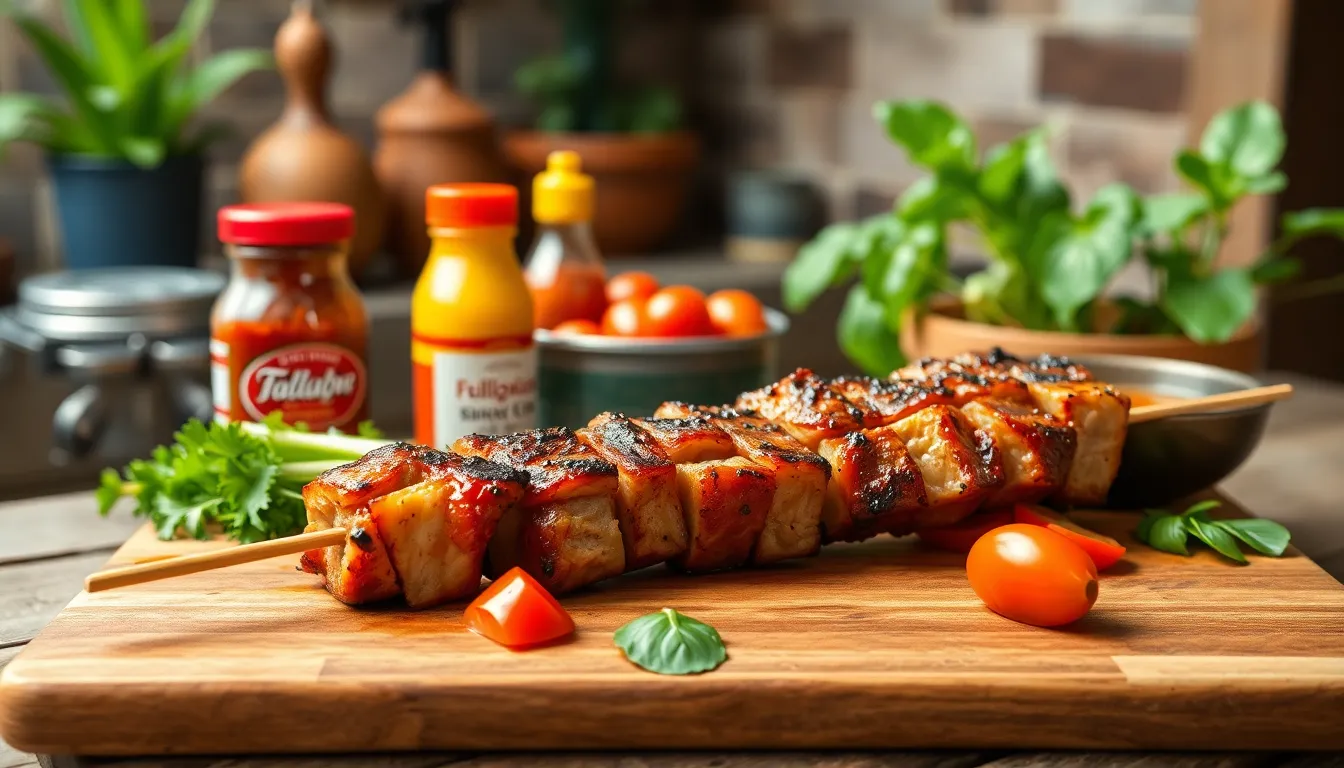
We can extend the enjoyment of our Filipino pork BBQ by following proper storage and reheating techniques that preserve both flavor and texture. After grilling our perfectly marinated skewers we should allow them to cool completely before transferring to airtight containers.
Our leftover BBQ will stay fresh in the refrigerator for up to 3 days when stored properly. We recommend removing the pork from the skewers before storing to prevent the wood from absorbing moisture and affecting the meat’s texture. Place the cooled pork pieces in glass containers or food-safe plastic containers with tight-fitting lids.
For longer storage we can freeze our Filipino pork BBQ for up to 3 months. Wrap individual portions in aluminum foil or freezer-safe bags to prevent freezer burn. Label each package with the date to track storage time effectively.
When reheating our stored BBQ we have several effective methods to restore its delicious qualities. The quickest approach involves microwaving for just a few seconds to maintain moisture and prevent the meat from drying out. We should cover the pork with a damp paper towel during microwaving to create steam that keeps the meat tender.
For optimal results we prefer reheating on the grill for 1 to 2 minutes per side. This method revives the smoky char while warming the meat through completely. Brush the pork lightly with reserved marinade or BBQ sauce during reheating to restore the glossy finish and enhance flavors.
Oven reheating works well for larger portions by preheating to 300°F and warming for 5 to 8 minutes. We wrap the pork in foil with a splash of marinade to prevent moisture loss during the reheating process. This gentle method ensures even warming without overcooking the already tender meat.
| Storage Method | Duration | Temperature |
|---|---|---|
| Refrigerator | 3 days | 35-40°F |
| Freezer | 3 months | 0°F or below |
We always check that reheated pork reaches an internal temperature of 165°F for food safety. Avoid reheating multiple times as this can compromise both texture and flavor quality of our Filipino BBQ masterpiece.
Variations and Tips
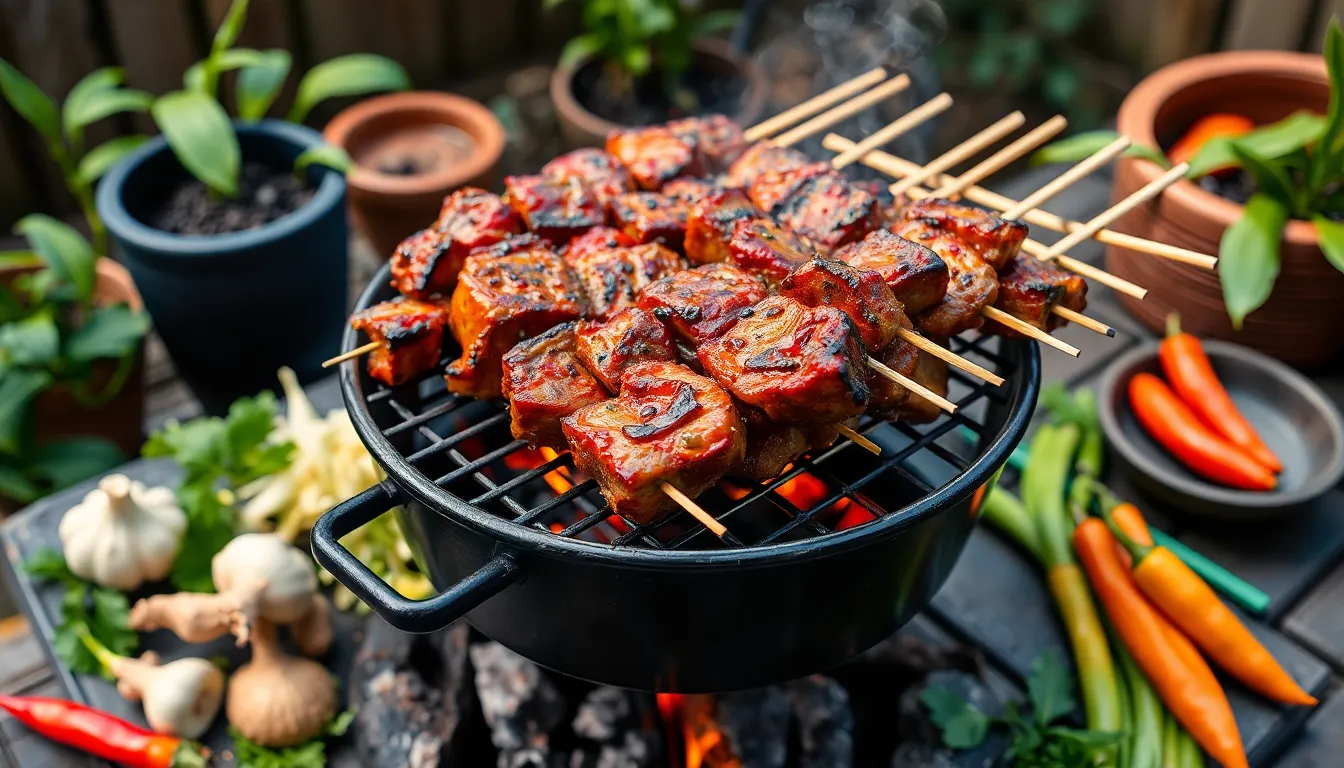
We’ve perfected our Filipino pork BBQ recipe through years of experimentation with different cuts and flavor combinations. These variations will help you customize the dish to your preferences while maintaining the authentic Filipino taste.
Different Cuts of Pork
We recommend pork shoulder or pork butt as our top choice for Filipino BBQ because these cuts offer the perfect balance of lean meat and marbled fat. The fatty portions keep the meat moist during grilling while the lean sections provide substantial texture that holds up well on skewers.
Pork belly works beautifully as an alternative cut when you want extra richness and juiciness. We cut pork belly into slightly thicker pieces since the high fat content can cause flare-ups on the grill. The result delivers incredibly tender meat with crispy edges that caramelize perfectly.
Pork tenderloin serves as an excellent option for those preferring leaner meat. We marinate tenderloin for shorter periods since the delicate texture absorbs flavors quickly. This cut requires careful monitoring during grilling to prevent overcooking and drying out.
For budget-friendly options we suggest pork steaks or country-style ribs. These cuts need longer marination times and benefit from lower grilling temperatures. The extra cooking time allows the connective tissues to break down and creates fall-off-the-bone tenderness.
Flavor Variations
We enhance our base marinade with oyster sauce to add umami depth and create a richer flavor profile. Start with 2-3 tablespoons of oyster sauce mixed into the standard marinade for a more complex taste that balances the sweetness perfectly.
White vinegar or cane vinegar brings additional tang and helps tenderize the meat further. We add 1-4 cup of vinegar to our marinade when we want brighter acidity that cuts through the richness of the pork fat.
Siling labuyo or wild chili transforms our mild BBQ into a spicy version that delivers authentic Filipino heat. We recommend starting with 1-2 minced chilies and adjusting according to your spice tolerance. The heat pairs exceptionally well with the sweet banana ketchup base.
Fresh ginger adds warmth and aromatic complexity to our marinade. We grate 1-2 inches of fresh ginger root directly into the mixture for a subtle spicy note that complements the garlic beautifully.
Lemongrass creates a citrusy fragrance that elevates the overall flavor profile. We bruise 2-3 stalks of fresh lemongrass and add them to the marinade for an authentic Southeast Asian touch that makes our BBQ stand out.
Different soda variations change the flavor subtly while maintaining the tenderizing effect. We experiment with Sprite for extra citrus notes or ginger ale for mild spice warmth. Root beer creates an interesting molasses undertone that works surprisingly well with the pork.
Conclusion
We’ve shared everything you need to master this beloved Filipino street food classic. The key lies in that overnight marinade and the perfect balance of sweet soy sauce and tangy calamansi juice.
Whether you’re grilling for a weekend cookout or introducing friends to Filipino cuisine this recipe delivers authentic flavors every time. The combination of tender marinated pork and that glossy BBQ sauce creates an unforgettable dining experience.
Start with quality pork shoulder follow our marination timeline and don’t skip the basting process. Your guests will be asking for the recipe before they’ve finished their first skewer.
Fire up that grill and bring the vibrant tastes of the Philippines to your backyard. This Filipino pork BBQ will quickly become your go-to recipe for any gathering.
Frequently Asked Questions
What makes Filipino Pork BBQ different from regular barbecue?
Filipino Pork BBQ features a unique sweet-savory marinade made with soy sauce, brown sugar, banana ketchup, and calamansi juice. The overnight marination process and traditional ingredients like banana ketchup create a distinctive caramelized glaze that sets it apart from other barbecue styles.
How long should I marinate the pork for best results?
Marinate the pork for at least 3-4 hours, but overnight marination (8-24 hours) is ideal for maximum flavor and tenderness. The acids from calamansi juice help tenderize the meat while the marinade penetrates deeply into the pork.
What’s the best cut of pork to use for Filipino BBQ?
Pork shoulder or pork butt are ideal choices due to their perfect balance of lean meat and fat. These cuts stay juicy during grilling and absorb the marinade well. Cut the meat into 1-2 inch pieces for even cooking.
Can I cook Filipino Pork BBQ without a grill?
Yes! You can oven-bake at 375°F on a wire rack or pan-fry in a hot skillet. Both methods require frequent basting with reserved marinade and cooking until the internal temperature reaches 145°F for food safety.
What should I serve with Filipino Pork BBQ?
Traditional sides include steamed jasmine rice, atchara (pickled green papaya), and steamed vegetables like kangkong. Garlic fried rice or coconut rice also pair excellently. For special occasions, add lumpia shanghai or fresh spring rolls.
How do I store leftover Filipino Pork BBQ?
Cool the grilled skewers completely before storing in airtight containers. Refrigerate for up to 3 days or freeze for up to 3 months. Reheat using microwave, grill, or oven until internal temperature reaches 165°F.
What can I substitute for calamansi juice?
If calamansi juice is unavailable, use fresh lime juice or lemon juice as a substitute. The citrus acidity is essential for tenderizing the meat and balancing the sweet flavors in the marinade.
Why do I need to soak wooden skewers?
Soak bamboo skewers in water for at least 30 minutes before grilling to prevent them from burning during the cooking process. This ensures your skewers remain intact and safe to handle throughout grilling.

